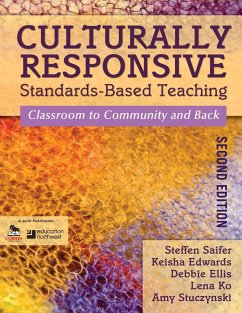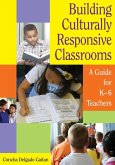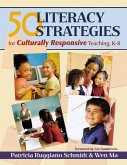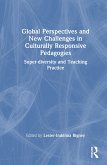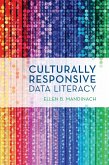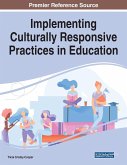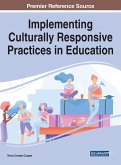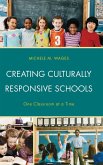Steffen Saifer, Keisha Edwards, Debbie Ellis
Culturally Responsive Standards-Based Teaching
Classroom to Community and Back
Steffen Saifer, Keisha Edwards, Debbie Ellis
Culturally Responsive Standards-Based Teaching
Classroom to Community and Back
- Broschiertes Buch
- Merkliste
- Auf die Merkliste
- Bewerten Bewerten
- Teilen
- Produkt teilen
- Produkterinnerung
- Produkterinnerung
Close the achievement gap by closing the culture gap Teaching children from diverse backgrounds begins with learning who they are, then using the knowledge and culture students bring
Andere Kunden interessierten sich auch für
![Building Culturally Responsive Classrooms Building Culturally Responsive Classrooms]() Concha Delgado GaitanBuilding Culturally Responsive Classrooms39,99 €
Concha Delgado GaitanBuilding Culturally Responsive Classrooms39,99 €![50 Literacy Strategies for Culturally Responsive Teaching, K-8 50 Literacy Strategies for Culturally Responsive Teaching, K-8]() Patricia Ruggiano Schmidt50 Literacy Strategies for Culturally Responsive Teaching, K-839,99 €
Patricia Ruggiano Schmidt50 Literacy Strategies for Culturally Responsive Teaching, K-839,99 €![Global Perspectives and New Challenges in Culturally Responsive Pedagogies Global Perspectives and New Challenges in Culturally Responsive Pedagogies]() Global Perspectives and New Challenges in Culturally Responsive Pedagogies195,99 €
Global Perspectives and New Challenges in Culturally Responsive Pedagogies195,99 €![Culturally Responsive Data Literacy Culturally Responsive Data Literacy]() Ellen B. MandinachCulturally Responsive Data Literacy133,99 €
Ellen B. MandinachCulturally Responsive Data Literacy133,99 €![Implementing Culturally Responsive Practices in Education Implementing Culturally Responsive Practices in Education]() Implementing Culturally Responsive Practices in Education174,99 €
Implementing Culturally Responsive Practices in Education174,99 €![Implementing Culturally Responsive Practices in Education Implementing Culturally Responsive Practices in Education]() Implementing Culturally Responsive Practices in Education224,99 €
Implementing Culturally Responsive Practices in Education224,99 €![Creating Culturally Responsive Schools Creating Culturally Responsive Schools]() Michele WagesCreating Culturally Responsive Schools80,99 €
Michele WagesCreating Culturally Responsive Schools80,99 €-
-
-
Close the achievement gap by closing the culture gap Teaching children from diverse backgrounds begins with learning who they are, then using the knowledge and culture students bring
Hinweis: Dieser Artikel kann nur an eine deutsche Lieferadresse ausgeliefert werden.
Hinweis: Dieser Artikel kann nur an eine deutsche Lieferadresse ausgeliefert werden.
Produktdetails
- Produktdetails
- Verlag: Corwin
- 2. Auflage
- Seitenzahl: 250
- Erscheinungstermin: 22. November 2010
- Englisch
- Abmessung: 280mm x 216mm x 14mm
- Gewicht: 639g
- ISBN-13: 9781412987028
- ISBN-10: 1412987024
- Artikelnr.: 30835692
- Herstellerkennzeichnung
- Libri GmbH
- Europaallee 1
- 36244 Bad Hersfeld
- gpsr@libri.de
- Verlag: Corwin
- 2. Auflage
- Seitenzahl: 250
- Erscheinungstermin: 22. November 2010
- Englisch
- Abmessung: 280mm x 216mm x 14mm
- Gewicht: 639g
- ISBN-13: 9781412987028
- ISBN-10: 1412987024
- Artikelnr.: 30835692
- Herstellerkennzeichnung
- Libri GmbH
- Europaallee 1
- 36244 Bad Hersfeld
- gpsr@libri.de
Steffen Saifer has served as director of the Child and Family Program at Education Northwest since 2000 and as an adjunct faculty member at Portland State University since 1996, where he has taught graduate courses in education. His areas of work and expertise include cultural-historical activity theory, the role of play in human development, and school-family partnerships. Saifer has worked extensively in Russia and Eastern Europe, assisting in education curricula reform. He helped implement a graduate program in early childhood development at BRAC University in Dhaka, Bangladesh (co-funded by the Open Society Foundation). He is the author or co-author of numerous publications including Practical Solutions to Practically Every Problem: The Early Childhood Teacher's Manual (2003, Redleaf Press), and Education and the Culture of Democracy: Early Childhood Practice (1996, Open Society Institute).
Preface
List of Snapshots
List of Tools
Acknowledgments
About the Authors
1. Culturally Responsive Standards-Based Teaching
Learning From Students¿ Lives
Culturally Responsive and Standards-Based Together
Essential Elements
Implementing Culturally Responsive Standards-Based Teaching
Continuum of Options and Opportunities for Culturally Responsive
Standards-Based Teaching
2. Taking Stock of Current Classroom Practices
Finding Time and Resources
3. The Foundation for Culturally Responsive Standards-Based Teaching
Getting to Know Your Cultural Self
Building Relationships With Students
Connecting With Families and the Community
Powerful Relationships Can Be Transformational
4. The Environment for Culturally Responsive Standards-Based Teaching
Incorporating Culturally Responsive Materials Into the Environment
Engaging in Conversation
5. Culturally Responsive Standards-Based Curriculum
Using Standards in Curriculum Planning
Adding Culturally Responsive Standards-Based Practices to the Existing
Curriculum
Creating Culturally Responsive Standards-Based Lessons and Units
Developing Culturally Responsive Standards-Based Projects
Developing Culturally Responsive Standards-Based Interdisciplinary
Activities
6. Assessment and Reflection
Student Assessment
Reflection
Gathering Feedback From Families
7. Scaling Up: From Schoolwide to State-Level Efforts
Whole-School Focus on Culturally Responsive Standards-Based Teaching and
Learning
Effective Ongoing Professional Development
Taking Culturally Responsive Standards-Based Efforts to the District Level
Statewide Efforts
8. Teachers Learning and Growing With Culturally Responsive Standards-Based
Teaching
Conclusion
9. Background Research and Theoretical Base
Enhancing Engagement and Motivation in Learning
Creating Academic Rigor and Challenging Curricula
Improving Partnerships With Families and the Community
Resources
Glossary of Terms
References
Index
List of Snapshots
List of Tools
Acknowledgments
About the Authors
1. Culturally Responsive Standards-Based Teaching
Learning From Students¿ Lives
Culturally Responsive and Standards-Based Together
Essential Elements
Implementing Culturally Responsive Standards-Based Teaching
Continuum of Options and Opportunities for Culturally Responsive
Standards-Based Teaching
2. Taking Stock of Current Classroom Practices
Finding Time and Resources
3. The Foundation for Culturally Responsive Standards-Based Teaching
Getting to Know Your Cultural Self
Building Relationships With Students
Connecting With Families and the Community
Powerful Relationships Can Be Transformational
4. The Environment for Culturally Responsive Standards-Based Teaching
Incorporating Culturally Responsive Materials Into the Environment
Engaging in Conversation
5. Culturally Responsive Standards-Based Curriculum
Using Standards in Curriculum Planning
Adding Culturally Responsive Standards-Based Practices to the Existing
Curriculum
Creating Culturally Responsive Standards-Based Lessons and Units
Developing Culturally Responsive Standards-Based Projects
Developing Culturally Responsive Standards-Based Interdisciplinary
Activities
6. Assessment and Reflection
Student Assessment
Reflection
Gathering Feedback From Families
7. Scaling Up: From Schoolwide to State-Level Efforts
Whole-School Focus on Culturally Responsive Standards-Based Teaching and
Learning
Effective Ongoing Professional Development
Taking Culturally Responsive Standards-Based Efforts to the District Level
Statewide Efforts
8. Teachers Learning and Growing With Culturally Responsive Standards-Based
Teaching
Conclusion
9. Background Research and Theoretical Base
Enhancing Engagement and Motivation in Learning
Creating Academic Rigor and Challenging Curricula
Improving Partnerships With Families and the Community
Resources
Glossary of Terms
References
Index
Preface
List of Snapshots
List of Tools
Acknowledgments
About the Authors
1. Culturally Responsive Standards-Based Teaching
Learning From Students¿ Lives
Culturally Responsive and Standards-Based Together
Essential Elements
Implementing Culturally Responsive Standards-Based Teaching
Continuum of Options and Opportunities for Culturally Responsive
Standards-Based Teaching
2. Taking Stock of Current Classroom Practices
Finding Time and Resources
3. The Foundation for Culturally Responsive Standards-Based Teaching
Getting to Know Your Cultural Self
Building Relationships With Students
Connecting With Families and the Community
Powerful Relationships Can Be Transformational
4. The Environment for Culturally Responsive Standards-Based Teaching
Incorporating Culturally Responsive Materials Into the Environment
Engaging in Conversation
5. Culturally Responsive Standards-Based Curriculum
Using Standards in Curriculum Planning
Adding Culturally Responsive Standards-Based Practices to the Existing
Curriculum
Creating Culturally Responsive Standards-Based Lessons and Units
Developing Culturally Responsive Standards-Based Projects
Developing Culturally Responsive Standards-Based Interdisciplinary
Activities
6. Assessment and Reflection
Student Assessment
Reflection
Gathering Feedback From Families
7. Scaling Up: From Schoolwide to State-Level Efforts
Whole-School Focus on Culturally Responsive Standards-Based Teaching and
Learning
Effective Ongoing Professional Development
Taking Culturally Responsive Standards-Based Efforts to the District Level
Statewide Efforts
8. Teachers Learning and Growing With Culturally Responsive Standards-Based
Teaching
Conclusion
9. Background Research and Theoretical Base
Enhancing Engagement and Motivation in Learning
Creating Academic Rigor and Challenging Curricula
Improving Partnerships With Families and the Community
Resources
Glossary of Terms
References
Index
List of Snapshots
List of Tools
Acknowledgments
About the Authors
1. Culturally Responsive Standards-Based Teaching
Learning From Students¿ Lives
Culturally Responsive and Standards-Based Together
Essential Elements
Implementing Culturally Responsive Standards-Based Teaching
Continuum of Options and Opportunities for Culturally Responsive
Standards-Based Teaching
2. Taking Stock of Current Classroom Practices
Finding Time and Resources
3. The Foundation for Culturally Responsive Standards-Based Teaching
Getting to Know Your Cultural Self
Building Relationships With Students
Connecting With Families and the Community
Powerful Relationships Can Be Transformational
4. The Environment for Culturally Responsive Standards-Based Teaching
Incorporating Culturally Responsive Materials Into the Environment
Engaging in Conversation
5. Culturally Responsive Standards-Based Curriculum
Using Standards in Curriculum Planning
Adding Culturally Responsive Standards-Based Practices to the Existing
Curriculum
Creating Culturally Responsive Standards-Based Lessons and Units
Developing Culturally Responsive Standards-Based Projects
Developing Culturally Responsive Standards-Based Interdisciplinary
Activities
6. Assessment and Reflection
Student Assessment
Reflection
Gathering Feedback From Families
7. Scaling Up: From Schoolwide to State-Level Efforts
Whole-School Focus on Culturally Responsive Standards-Based Teaching and
Learning
Effective Ongoing Professional Development
Taking Culturally Responsive Standards-Based Efforts to the District Level
Statewide Efforts
8. Teachers Learning and Growing With Culturally Responsive Standards-Based
Teaching
Conclusion
9. Background Research and Theoretical Base
Enhancing Engagement and Motivation in Learning
Creating Academic Rigor and Challenging Curricula
Improving Partnerships With Families and the Community
Resources
Glossary of Terms
References
Index

